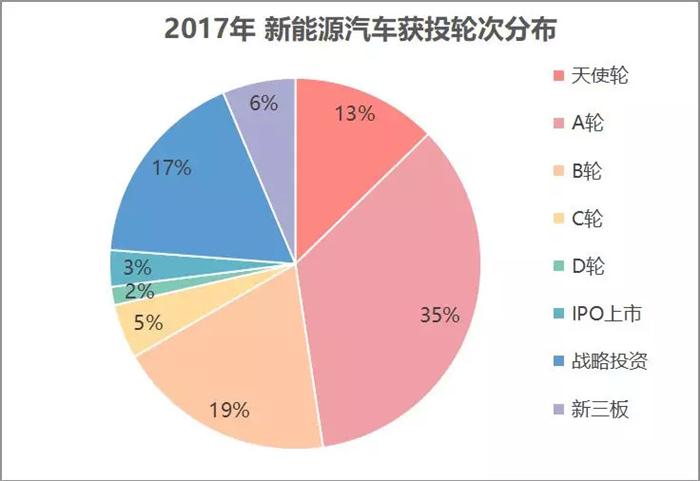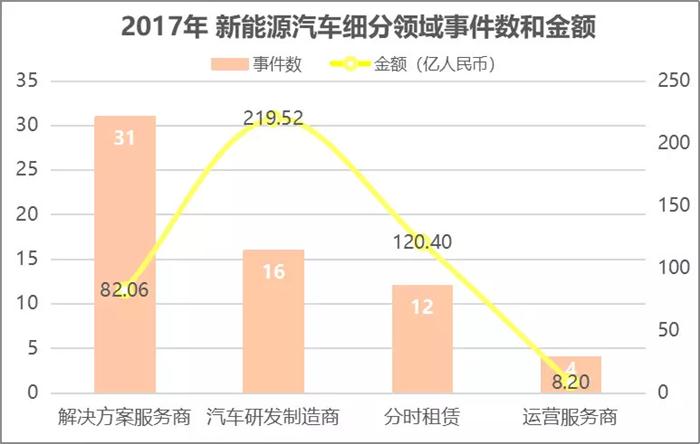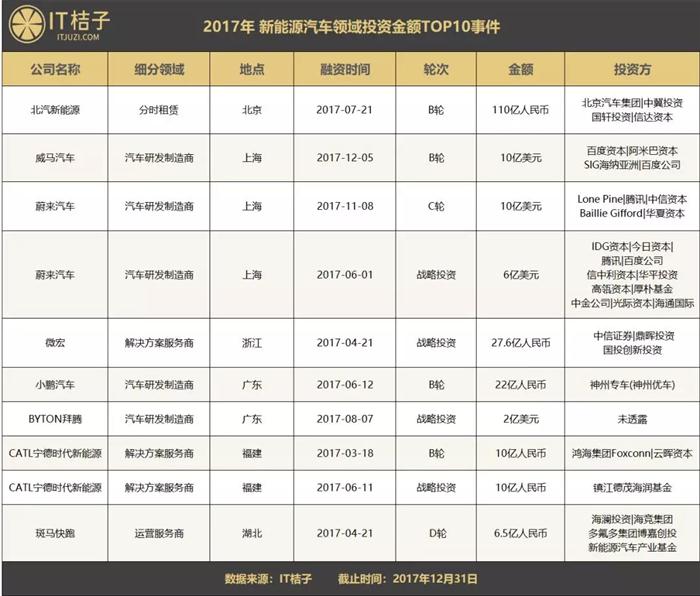In 2017, there was a vigorous construction movement in China. Regardless of whether it is a newly-built automobile manufacturer, a traditional car company or BAT, it is deploying new energy vehicles (mainly electric vehicles) and automatic driving technology. Frequent rush to finance large-scale financing events for new car makers According to statistics of IT oranges, in 2017, there were 63 investment events in the area of ​​new energy vehicles, involving a total amount of RMB 43.018 billion and an average single financing amount of RMB 683 million. These investment events covered four areas, including: R&D and manufacturing of new energy vehicles (whole vehicle R&D, production and manufacturing), and new energy automotive solution providers (mainly including charging piles, batteries, energy storage, power systems, and new Energy-related automotive core component solutions service providers, new energy vehicle time-of-day leasing service providers, and new energy automobile operation service providers (including vehicle operations related to new energy vehicles, such as: network vehicles, logistics and transportation services) . From the distribution of new energy vehicles in 2017, the early investment events (referring to the A-round and previous investment events) accounted for 48% of the total and were mainly concentrated in the A-round phase. In addition, the proportion of Phase B and strategic investment events is also very large, with 19% and 17%, respectively. As a whole, the new energy automobile industry is still in a relatively early stage. With the development of the new energy automobile industry, more players will enter the entire industry chain. From the perspective of the number of investment events and the amount of investment in the new energy vehicle segment, the number of new energy automotive solution service providers has been the most, and the amount of investment for the automotive R&D manufacturers has been the most. It can be seen that the R&D and manufacturing of the vehicle is indeed a very large investment project. Therefore, 16 investment events in this sector have obtained RMB 21.952 billion in financing, and the average single financing is RMB 1.372 billion, which is much higher than other industries. For example, the head company of the new energy automobile field, “Very new automobileâ€, got two rounds of financing in 2017, which were US$600 million and US$1 billion respectively; Weima Motor received US$1 billion in round B financing; Xiaopeng Automobile A was awarded RMB 2.2 billion; BYTON received $200 million in strategic investment. In addition, 12 investment events in the time-shared leasing sector attracted RMB 12.04 billion, which was mainly related to the RMB 11 billion B round of financing of BAIC New Energy. The following is the TOP10 form of the major financing events in the new energy automotive industry in 2017: Newly-built car companies, BATs, and traditional car companies enter the office one after another, and the automotive industry usher in change As for newly-built automakers, the first echelon start-up companies are Weilai Auto and Weimar Auto, both of which had received billions of dollars in large-scale financing in 2017. Among them, after Weilai Automobile released the world’s fastest super NIO EP9 at the end of 2016, its first production car, the ES8, was officially launched on December 16, 2017, with a pre-subsidy price of RMB 448,000 as the benchmark. The battery rental program; and the first mass production model of Weimar Automobile was also unveiled on December 11, 2017, with a starting price of 200,000 and a maximum life of 600 kilometers. Compared to Jia Yueting's LeTV, the two companies' vehicle construction plans are steadily advancing. BAT is also in the layout of the automotive sector. Baidu All in AI, entered the field of automated driving, launched the Apollo plan, and reached a strategic cooperation with BAIC, and invested in Weilai Automobile and Weimar Automobile; Alion pushed the AliOS vehicle system, reached a strategic cooperation with SAIC and invested in Xiaopeng Automobile. Tencent is committed to building Tencent’s AI in Car system for the next generation of Wi-Fi vehicles, and has reached a strategic cooperation with Guangzhou Automobile and invested in Weilai, Weimar, Tesla and German Airlines that manufactures electric flying cars. Lilium. From the perspective of the dynamics of traditional car companies, Volkswagen will develop new energy vehicles and will work with Chinese partners to invest 10 billion euros (about 12 billion U.S. dollars) in China before 2025; SAIC and Ningde will join forces With over 100 billion yuan of large-scale investment in the field of new energy vehicle batteries, the company will build a highly intelligent, green and environmentally advanced battery and battery system production base in accordance with world-class, domestic-leading standards; Guangzhou Automobile has established a wholly-owned subsidiary of Guangzhou Automobile New Energy Automobile Co., Ltd. The company has a total investment of 600 million yuan, and plans to invest RMB 1.28 billion in cooperation with Weilai to establish a new energy vehicle company; Beiqi Investment and Investment will set up a 10 billion yuan investment fund for new energy vehicles, and will in the future stimulate the social capital of the scale of 100 billion yuan. Participate in promoting the development of new energy automotive industry; Chery plans to invest 3 billion yuan to establish a new energy automobile production base in Shijiazhuang, Hebei, and is expected to put into production small new energy vehicles in the future and establish a production base for new energy vehicles; Great Wall Motors announced that it will make new energy vehicles in the next decade. The basic science and technology investment is 86.7 billion U.S. dollars... Whether it is a newly-built car maker or a BAT Internet giant, they have all launched their own smart car systems to lay out the auto industry chain in cooperation with or investing in traditional car companies. In addition, the traditional car companies have also increased investment in the field of new energy vehicles. We can see that the traditional automotive industry is ushering in new changes. Policies are favorable to drive the development of the industry The advent of “Motor Construction†was due to ambitious entrepreneurs who were unwilling to abandon this “turning overtaking†opportunity and on the other hand benefited from the subsidies of national policies. At the national level, at present, China’s crude oil industry is heavily dependent on foreign countries. In 2016, foreign dependence reached 65.4%. Experts expect that the 2018 is likely to exceed 70%. The development of new energy vehicles will have a longer-term strategic significance for China's energy layout. Therefore, many policies have been issued at the government level to actively guide the development of this sector. In particular, the cash subsidy policy has greatly increased the enthusiasm of the new energy automakers and thus ensured the supply of new energy vehicles. Data from the Ministry of Industry and Information Technology shows that in 2016, the number of new energy vehicles declared by enterprises was 94,072 units, enterprises had applied for liquidation funds of 6.415 billion yuan, and the number of promotion approved by the expert group was 85,095 units, and the subsidy funds for liquidation should have been 5.86 billion yuan. At the same time, at the demand-side level, preferential policies such as easy-to-use and unlimited-opening policies brought about by favorable policies are the key factors for the willingness of owners to choose new energy vehicles, especially in domestic cities such as Beijing, Shanghai, Guangzhou, Shenzhen, and Hangzhou. In Tianjin, the cumulative sales of new energy vehicles are all in TOP6. Potential crisis and current difficulties With the continuous improvement of the penetration and retention of new energy vehicles in China, the industrial development has entered a new stage. However, the unbalanced development problems that accompany it have also become increasingly prominent. Not long ago, Minister of Industry and Information Technology Miao Wei's speech pointed out the potential crisis and dilemma of the current development of China's new energy automotive industry: First, charging infrastructure is still a shortcoming of development. The problem of insufficient structural supply of charging infrastructure is increasingly prominent, and the overall scale is still lagging behind. The layout of charging facilities is also not reasonable enough. The utilization rate of public charging piles is less than 15%, and the sustainable business development model has not yet been formed. There is a two-way contradiction between the difficulty of operating corporate profits and the high price of consumer charging. Second, the policy system still needs improvement. The development of the entire country's new energy automotive industry also depends on the continuous improvement of the policy system. The policies from the central government to local governments also need to be well connected, breaking local protectionism and accelerating the landing of policies. Third, the core technology needs further breakthroughs. Further breakthroughs in core technologies such as power batteries still require greater innovation and investment in R&D. With companies as the mainstay, the innovation system that combines production, education and research needs to be improved. Fourth, the post-market circulation service system needs to be improved. The after-sales service supporting system lags behind and has a certain negative impact on cultivating the consumer market. At the same time, the lack of evaluation standards for new energy vehicles used car market, the unsound circulation system, and the low rate of vehicle maintenance have affected the long-term development of the new car market. The development of the new energy automobile industry is both a historical opportunity and a challenge for China. It is an important breakthrough for China to build a powerful automobile country. If China wants to realize its goal of transforming itself from a big automobile country to a powerful automobile country at an early date, it must rely on the unremitting efforts of the government, enterprises, universities, scientific research institutions, and practitioners in the industry. Chlorine Test Strips,Good Chlorine Test Strips,Sanitizer Chlorine Test Paper,Custom Chlorine Test Kits Jilin Test Bio-Electron Co., Ltd , https://www.tst-check.com
![]()

![]()

![]()
The national standard is, factory water ≥0.3ppm, pipe network terminal water ≥0.05ppm;
The residual chlorine value is too high, and the stench of chlorine in the water will be very strong, which will not only stimulate the human respiratory system and eyes, but also may lead to allergies in many people.
The residual chlorine value is too low, the disinfection effect cannot be guaranteed, and the bacteria content in the water exceeds the standard, endangering human health.
Algae can also multiply rapidly, turning the water green and muddy, and accelerating pollution.
State regulations, swimming pool residual chlorine content in 0.3-0.5mg/L.